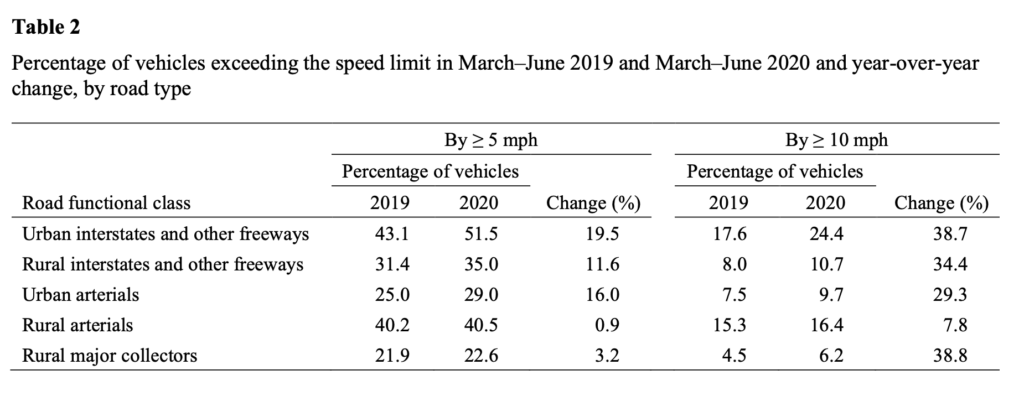
IIHS says increased speeding, a result of pandemic lockdowns, has become ‘the new normal’
By onAnnouncements | Insurance
A new study by the Insurance Institute for Highway Safety (IIHS) has found that speeding increased during the morning and afternoon commuting hours during the COVID-19 pandemic, and has not returned to pre-pandemic levels.
An analysis of data from 506 Virginia Department of Transportation (VDOT) speed counters showed that the chances a driver was exceeding the speed limit by at least 10 mph rose a little more than 50% during March-June 2020, when a stay-at-home order was in place, compared with the same period a year earlier, IIHS said.
Federal data collected since then shows that “the increase in speeding and other risky driving behaviors continued throughout 2020 and 2021,” the institute said in announcing the results.
Overall, IIHS said, traffic volumes at the study sites fell by a quarter during Virginia’s lockdown.
“The empty roads probably tempted pandemic-stressed drivers to put the pedal down,” Jessica Cicchino, vice president of research at IIHS, said in a statement. “But information collected since the lockdowns ended and the roads filled back up suggests that risky driving has become the new normal.”
The study, written by Cicchino and Jin Wang, recommends that “Future research should continue to identify where and when speeding problems are most severe, and countermeasures should be directed to the roads and time periods with the largest speeding problems.”
Those countermeasures should include “proven solutions that have been shown to prevent speeding,” Cicchino said, “like automated speed enforcement and road designs that slow traffic.”
Other studies have drawn a connection between higher speeds and increased severity, and an increase in the proportion of total loss claims. CCC Intelligent Solutions’ 2022 Crash Report found that speeding, as well as other risky behaviors like alcohol and drug use, “were tied closely to the COVID-19 pandemic and key factors driving increases in motor vehicle fatalities and motor vehicle accident severity over the past two years.”
The IIHS study found that the proportion of speeding vehicles was highest on urban interstates/other freeways and urban arterials. In 2019, more than 40% of vehicles on those roads were exceeding the speed limit by at least 5 mph, and more than 15% by at least 10 mph. In 2020, the proportion of vehicles exceeding the speed limit by at least 5 mph increased by 16% on urban arterials, 20% on urban freeways, and 12% on rural freeways, but did not change much on rural arterials or collectors. The proportion of vehicles speeding by 10 mph or more increased by around 30% to 40% on all road types except rural arterials.
The increases in the proportion of speeders were highest on urban interstates and other freeways during early morning (6-8:59 a.m.) and afternoon commuting hours (3-5:59 p.m.) on weekdays, and during afternoons (12-5:59 p.m.) on weekends, the study said.
Statistical analysis revealed that the risk of speeding by at least 5 mph increased by 22%, and by at least 10 mph by 51%, after accounting for road type, time of day, day of week, and traffic volume.
As other studies have shown, higher speeds “raise the likelihood of crashes as well as their severity,” IIHS said. “As speeds increase, drivers have less control over their vehicles and less time to respond to hazards. At the same time, the risk of injury to people involved in crashes rises because crash energy increases exponentially with increasing speed.”
Citing its own unpublished data from 2021, the institute noted that speeding has been a contributing factor in over a quarter of all fatal motor vehicle crashes for more than two decades.
In its 2022 Crash Course, CCC drew similar conclusions.
“With many vehicles traveling at faster speeds on less congested roads during the pandemic, vehicles in accidents were seeing higher Delta-v’s, with greater damage to both the vehicle and its occupants. Delta-v is a measure of a collision’s severity or force,” CCC said.
It found that “freer moving traffic has resulted in higher speeds, and potentially more severe accidents. These shifts in traffic patterns and accident severity could also have a meaningful impact on technologies like ADAS to be able to reduce accident frequency.”
IIHS said its study “adds to the body of knowledge on the effect of the COVID-19 pandemic on traffic safety.”
More information
CCC 2022 Crash Course
https://cccis.com/crash-course-2022/
Images
A device measures the speed of vehicles. (River North Photography/iStock)
